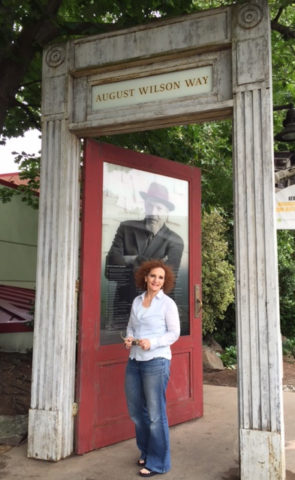Essays on Art, Culture, and Design #1- Exhibition Design

Well, it is almost my birthday — an inconvenient two days after Christmas — and I did promise myself that I would post in my new blog. I also promised that I would write about art, design, and culture.
Still, all I have written about lately is politics. I am a Facebook addict and I yell into that wind constantly, preaching to the small circle that some distant algorithm determined would be my closest friends. These friends do already agree with me for the most part. On the rare occasion that I “speak” with someone who doesn’t, I get both thrilled and somewhat scared and I tend to write so copiously in response that they are either put off or do not know where to begin to reference my tangents. I think that I come off as though I were heeding advice I read when I was in my teens about how to act crazy if you think that some guy is following you.
I do not mean for these Facebook people to steer clear and walk to the other side of the road. I mean to meet them in the middle …and then grab their arm and pull them to my side. Ok. It is true. I think that I am correct on many issues and points. Yet, I do think that we probably share values (about compassion and caring, and so on) and that there is a place in the middle and that, being convincing and charming, and with well cited sources of information, I will ease them into a semblance of, or at least momentary self-knowledge and sense that will change their ways and their voting inclinations. Admittedly (and I like admitting this), I too can be given new information that might change my mind. I realize that, if I expect someone else to shake off their own mental shackles, I must be ready to do some shaking myself. I try to remain open to this. And I know that there are things I do not know. So, at least I am not victimized by the Dunning-Kruger effect …though, how would I know? (That makes me laugh.)
Back to the point. I launched my website weeks ago with a section for news and blog, and a new post is getting to the point of overdue. Even though all I can think about is that the soon-to-be-loser-in-chief might slip us into a military winter or a climate catastrophe from which we will never emerge… I will focus. I will exercise my disciplined mind. And, here at least, I will get back to Culture. It is possible anyway that art will save the world. Let’s be reasonable. No. No. No. Let’s NOT be reasonable. But, let’s focus.
These days, at least once a week, I see a live performance. I read novels. I watch, and even binge watch clever shows on non-broadcast non-stations. I meet friends to discuss art. I visit museums. I come up long lists of art pieces and projects that I would like to propose to people with money and influence. When old friends ask what I am doing, I say that I am turning down the volume on my design business and its work and turning up the volume on the solo studio stuff. People ask what intention I have for the new website and I am not sure, though I know that it is more to get a new level of recognition and a footing of authority than it is to get new work. I have no end of work. I work all of the time. I have a non-ending list of projects I do and am doing. I am lucky. And life is good. Therefore, the website is more portfolio and retrospective than it is application or supplication for a new job. As always, I wake up with a vague sense of guilt that I am not doing enough. But I do agree with Aunt Ester in August Wilson’s work in that I think that one must understand one’s past in order to go healthfully into the future.
And, so I will begin with a reflection on the business of exhibition design. Here is the first installment of reflections and essays on art, design, culture, and the work about it. Hope you enjoy.
_____
Exhibition Design 101
I have worked as an Exhibition Designer for about thirty years. Do you want to know everything I know as an exhibition designer? Here is what I have learned, along with some of the instructions I have given myself and the LCS staff about this type of work.
On an interpretive sign, in order to be legible and make the most impact, the main area of text (the body text) will mostly want to be between two feet and five feet above the finished floor. Titles can be above that. Odd miscellaneous text, such as captions, copyrights, and other acknowledgements, can be below. Use hierarchy in font size. Probably, you do not want text to be less than 14 points, unless it is for captions and other, rare miscellany. The area above five feet can be used for titles, but in larger font, or else it will not be readable enough, especially from afar. Pay attention to the contrast, spacing, and font style choices for legibility. You probably want about 75 words per sign but you can go to as many as 150. Over that quantity, it may as well be a newspaper or magazine – and you might as well just forget making an exhibit. However, it is generally a great challenge to get a client to agree to fewer words. To make the process most efficient and least frustrating, ask the client to have only one representative combine all of their review comments (and still you will be lucky if the client gives you reviews of your text with no contradictory remarks). The writing aspect of exhibit design takes much longer than you might expect. Everyone who writes thinks that they can write exhibit text, but there are rules about characters per line, lines per paragraph, paragraph per sign, and how all of this relates to the designs; how big, how far, who is reading… After initial writing, there are always words that may be edited out without losing meaning. Now you know this too.
Exhibition design is like architecture and takes all of the abilities of an architectural endeavor. It also goes through the same processes: Programming, Schematics, Design Development, Contract Documents, Construction Administration. It also has a parallel track of literal design aspects that result in Graphic Design, aspects that are essential to the work. While you are putting the three-dimensional process through its hoops, you are simultaneously working on two-dimension aspects including Research, Writing, Photos and Illustrations, and then the same process of Schematics, Design Development, Contract Documents, and Construction Administration (or Fabrication Administration, if you prefer) for this aspect of the work too. Contract Documents include Working Drawings and also gruelingly time-consuming, eye-crossingly complicated, and often boring-to-write, though necessary Specifications (which are the detailed written instructions that accompany the Drawings).
Exhibition design is a Renaissance Man’s endeavor (or, if the term “Man” offends you, a polymath’s endeavor). Depending upon the project, you may work with structural engineers, landscape designers, architects, lighting designers, mechanical engineers, electrical engineers, AV and multi-media experts, civil engineers, illustrators, photographers, writers, researchers, scientists, artists, teachers, administrators, politicians, metal workers, glass workers, woodworkers, animators, sign makers, and others. And you will have to know more than a little about each and all of their fields to work intelligently with them. You will be responsible to oversee Shop Drawings, Samples, and Prototypes. You will have to know where the materials and items you plan to use in your designs come from, how they age, what they cost, if and/or how they can be replaced over time. You will want to know everything you can about sustainability and environmentally-conscientious design — otherwise, why design at all? You will have to understand materials, lighting, composition, color, and have an impeccable business acumen. In Exhibition Design you really have to understand how people/visitors experience space, and exhibits in particular, which is also about the psychology of learning. The visitor experience is the point. You will have to be cognizant of curricula and the most current thinking in the field of Education. You will work, on average, one and a half to two years on any particular project, although often longer.
If you run your own business, the work of everyone who works for you — a staff of people you manage and for whose happiness you feel partially responsible — will ultimately be your responsibility and, at the same time, you will try to give them the recognition that they deserve, sometimes going overboard in this empathetic compensation and relinquishing your own reward. And you will be a therapist to your clients who are frequently comprised of multiple people who do not necessarily agree and sometimes would like to kill each other.
You will have to compete for almost every job you get. Clients will say that they want you to go all out and as far out as possible, and when you do, they will forcibly snap you back to their comfort zone. No one, not even your loving family, will understand what you do. Journalists will not mention you and might, in canonizing the hero architect, even give that architect credit for your work. It is likely that you will not have time to engage much in marketing efforts, unless you are willing to relinquish being involved in the work for which you have a passion and which brought you to where you are in the first place. You will spend hours upon hours managing your business and understanding the tax structure. You may try to raise your fees but project proposals will almost always be for fixed fees so that, once you get a project, you will work three to five hours for every one hour you are paid. Sometimes, you may have to buttress your firm and keep it afloat with your own savings. There will be no job security. Insurance costs are yours to pay, for you and your staff, and they will continue to precipitously rise. You will sometimes blurt out how you feel about all of this, with the risk that some people might think you are egoistical, obsessive, bitter (and, in my case, maybe a little neurotic)… and they may be right. Even in today’s world of rampant Hero Worshipping, it is hard to worship, or even recognize an Exhibition Designer, especially if she’s female and not very tall. And yet, you will often get into the Flow of it and feel a surge of happiness as good as life gets. You will often go home and feel as though you have done something worthwhile and you will have the satisfaction of often using so many of your talents. You will be one of the lucky few who enjoy their work more often than they dread it. You will feel satisfied and proud.
The point of Exhibition Design is, as far as I am concerned, to inspire positive change and action. The field of Exhibition Design is as complicated, important, and challenging as Architecture. And, even if I can tell you everything I know and you can follow every step, you still may not become a great designer. Because, beyond it all, there is that magical element. Intuition and character and persistence and wit, and maybe luck… whatever the brew is that, in your personal way, brings it all together.
What ya don’t know. Now you know.


